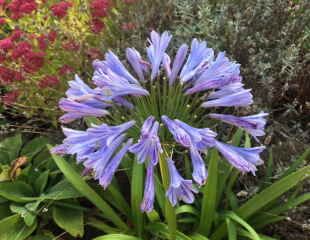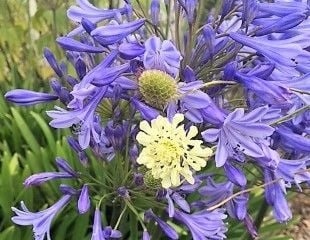

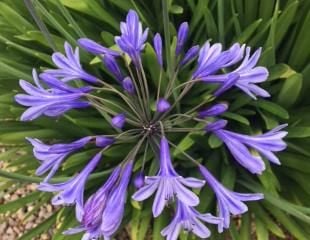
How to Grow Agapanthus
Key Facts:
Height: varies from .5m - 1.5
Light: Agapanthus flowers best in full sun but will tolerate light shade
Soil: Any free-draining
Maintenance: There are both evergreen and deciduous varieties. Some Agapanthus are fully hardy, others less so and may require winter protection.
Special features:
Agapanthus is a summer-flowering perennial plant grown from rhizomes. It has exotic-looking flowers in striking shades of blue, mauve, and white.
Growing Agapanthus is easy. Getting them to flower is trickier. The ideal growing conditions are full sun with fertile, moist but well-drained soil and in a sheltered garden. Agapanthus belongs to that select group of plants that are in flower for a long time, providing colour in the border for weeks, see images below.

Agapanthus are marked with an amber wheelbarrow, indicating they can be a bit tricky to get to flower, and some varieties are not fully hardy and need winter protection
How hardy is Agapanthus?
Varieties of Agapanthus vary in hardiness and in the extent they will tolerate frost and cold. For the best results, it is important to select the most suitable variety for your garden and to select the right planting place. Like so many of our garden favourites, when growing Agapanthus, the trick is to get the "right plant in the right place," and this is very much the case with Agapanthus.
As a rule of thumb, the deciduous varieties of Agapanthus are more hardy than the evergreen varieties, and the less hardy types will need a winter mulch and frost protection.
In more exposed gardens plant a fully hardy variety, H4, which is hardy to a range of -5-10. Good hardy varieties in this group include readily available varieties such as A. Blue giant, (deciduous) A. Midnight blue (semi-evergreen), A. Lilliput (deciduous) as you may expect a short variety up to 10cms A. Snowy Owl with white flowers (deciduous). More about frost hardy.
How to get Agapanthus to Flower
So, what is the trick to getting Agapanthus to flower?
As always with plants that can be shy to flower, if you can, buy one that is in flower.
One of the primary causes of a lack of flowers is insufficient sunlight. Agapanthus requires at least 6 hours of sunlight per day.
It is said that constricting the plants' roots helps, especially with young plants. Start in containers. I started all my agapanthus in containers, and they have all flowered, remaining in the containers for several years. Only recently, after around 4 years, have I moved a selection out into the border, where they have continued to flower.
Feed with high-potash feed, such as tomato feed, from when they start growing in the spring until around the end of September.
Don't be quick to divide them. Agapanthus are best left undisturbed and only divide when necessary.
Give good winter protection to the less hardy varieties with a layer of mulch or fleece.
If you have Agapanthus growing in the ground, and they are not flowering, dig them up. Plant them in a tight container to constrain the roots, and they will (almost certainly) flower the next year.
In some areas of the UK, getting Agapanthus to flower is more of a challenge. In poor conditions (exposed and wet) I tried to grow Agapanthus in the border, they sulked and declined to flower. Being reluctant to abandon such expensive plants, I dug them up and potted them into large containers, and two years later, the flowers put in an appearance.
How and where to plant Agapanthus
Soil conditions for Agapanthus
Agapanthus will grow in most soil but will not thrive on poor, thin, dry soil. Neither do they enjoy waterlogged soils. Plant into well-drained soil. To ensure the soil drains well, mix about 30% grit or perlite into a good-quality peat-free compost if you plant in containers.
Where to plant Agapanthus
You can plant Agapanthus any time during the growing season. The most important thing is to plant in full sun, or to place the container in a sunny spot. If planting Agapanthus in a container, leave room for a winter mulch to protect the plant.
If you are planting as rhizomes, they should lie just a few centimetres below the surface. Mature plants should be at the same soil level.
All Agapanthus, both deciduous and evergreen varieties, will survive a winter best if planted in soil that is not wet. Whether in the ground or containers, Agapanthus does best in well-drained soil with plenty of organic matter.
Originating from South Africa, Agapanthus thrives in full sun
The taller varieties of Agapanthus look good in containers, adding style to a patio or entrance, and are an ideal balcony plant. Agapanthus will flower without feeding, but if you have time, it will encourage more blooms.
How to look after Agapanthus in the Winter
Looking after Agapanthus in the winter depends on both the variety you are growing and where in the country you garden. Having moved around the UK, I can say that there is a considerable difference in terms of rainfall, sunlight hours, temperatures and frost frequency in the different parts of the UK. Check the precise variety you are growing; as a general rule, the deciduous varieties are more hardy than the evergreen types.
The RHS hardy ratings take into account other aspects of hardiness apart from a simple temperature reading, as the aspect is also important. This makes it a more reliable measure of hardiness rating. Even though plants might be described as hardy, wet, cold ground can prevent them from surviving the winter.
Winter protection.
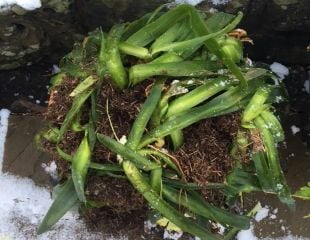
Ensure the original planting is in a sheltered spot.
Mulch before frost occurs.
In colder areas, grow in containers, which either move to a sheltered spot or Agapanthus can spend winter in the greenhouse.
The image shows an evergreen Agapanthus with winter mulch. I find Strulch is very good.
Below shows the difference in growing conditions.
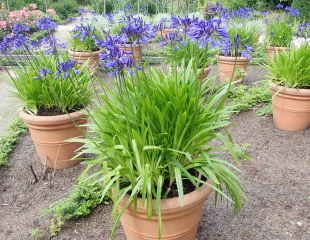
Agapanthus growing in Alnwick
I took this image of Agapanthus in the garden at Alnwick, which is in Northumberland. A nice garden to visit, with lots of Agapanthus growing in containers, no doubt to facilitate placing them in a sheltered spot/under glass for the winter

Agapanthus growing wild on Tresco
By contrast, Tresco in the Scilly Isles is a long way south. On the island, Agapanthus grow everywhere, semi-wild and love the growing conditions. Lots of sun,
How to re pot Agapanthus
If your container-grown Agapanthus are ceasing to flower, and they have been in the same container for a number of years, 5+, it may be time to repot them.
To do this, turn the Agapanthus out of the container. The image shows a pot-bound Agapanthus, with its tough, very compact roots. This is a deciduous variety early in the year, not yet in leaf.
Once out of the pot, cut it into 2/3/4 pieces (depending on its size), and you may need to do this with a sharp spade/bread knife, to cut into the bits. Don't worry that you are butchering the plant; it will come back with foliage the same year, and it may also flower, although sometimes not until the next year.
The best time to repot Agapanthus is spring . You can do it later, but the later you do it, the less chance of flowers that year. I had 5 large Agapanthus in containers, and it took time to get around them, dividing all, and repotting. The plants I repotted first, which were done earlier by about a month, flowered the same year, the others did not.
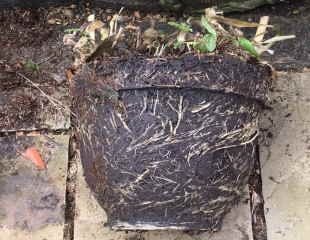
Good Varieties of Agapanthus to grow
Suttons on line have a great selection of Agapanthus ( affiliate links) including many of the varieties mentioned below, A. Fireworks, Pink Blush, White Crystal, Black Jack over 30 varieties.
The most hardy evergreens (H4) awarded the RHS garden merit are A. 'Blue Ice' as the name suggests a pale blue variety 85 cm, 'Megan's Mauve' a lavender variety110cm, 'Snow Cloud' a beautiful white variety. A. Midnight Star, a shorter variety with strong blue blooms.
Other deciduous varieties the AGM include 'Alan Street' described as one of the best in the trial a dark purple blue 115cm, ' Snow Crystal ' as the name suggests a white semi evergreen variety 60cm. A variety I really like is Fireworks, a two tone blue and white and available at Suttons.A semi-deciduous variety with bicoloured blue and white flowers it is very striking 65cm. Another blue and white varieties with the RHS garden merit award is A. Queen Mum and A. 'Fireworks'
A. Northern star and A royal Velvet are both strong blue varieties which are also hardier deciduous varieties
Other varieties of relatively hardy Agapanthus include A.'Ben Hope' dark blue flowers height up to 1.2m; A. 'Blue Giant' rich blue flowers similar height; and A. ' Blue Moon' light blue flowers growing up to 60cms. There is a hardier form of white Agapanthus ' Bressingham White' which has pure white flowers growing up to 90cms.
When selecting an Agapanthus for the garden, a good starting point is to check out those with the RHS AGM is a good starting point.

Interesting planting arrangement of Agapanthus

An unusually sheltered spot!
These Agapanthus thrive in the lee between two greenhouses, benefiting from the shelter and warmth provided by the two structures. In addition, it made the strip of soil between the greenhouses attractive and full of colour.
I took this image at Easton Walled Garden, which is full of clever planting and ideas, and well worth a visit.
Images of Agapanthus

Agapanthus growing in containers
Agapanthus grow well in containers and here in the garden at Alnwick gardens numerous Agapanthus are displayed in pots.
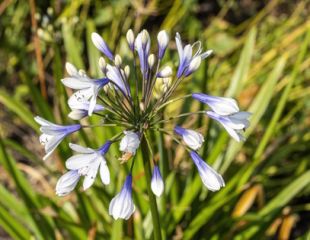
Agapanthus 'firework'
Another blue and white variety A. twister, described as hardy to -10, and grows up to 60cm it is an evergreen variety
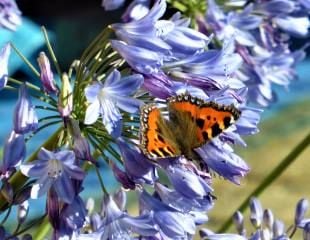
Agapanthus with butterfly
Agapanthus do attract their fair share of butterflies over a long period because of their long flowering nature.

Agapanthus in a border
In the right conditions, Agapanthus will grow well in a border and add colour and flowers for a long period.
Evergreen Agapanthus are long-flowering
I took these images of Agapanthus showing the blooms looking good. They were flowering unusually late because of the summer conditions, none the less the flowers looked good a month plus.
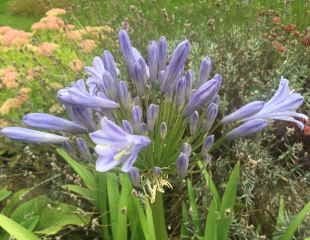
Agapanthus 11th September coming into bloom
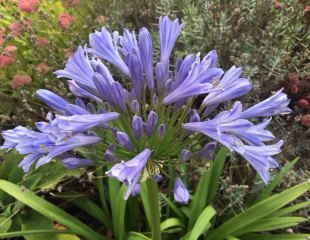
Agapanthus 17th September flowering well
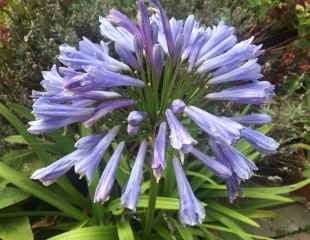
Agapanthus 3rd October
